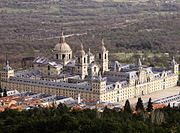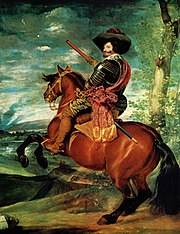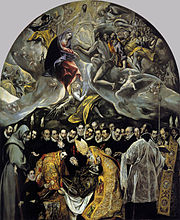Spanish Golden Age

The Royal Monastery of the Escorial, built by Philip II.
The Golden Age Spanish is the period of cultural influence of the Spanish to Europe in the seventeenth century. This period of great literary and artistic vitality in Spain and in Hispanic countries of Latin America coincides with the political decline and the end of the Habsburg dynasty in Spain with Philip III, Philip IV and Charles II.
Sometimes called Spanish Golden Age, the era of economic and political magnitude of the Spain that runs from the first half of the sixteenth century to the first half of the seventeenth century. The definition of the time period is usually quite vague, but never started before 1492, with the end of the reconquista and the voyages of Christopher Columbus to the New World and never completes after the independence of the United Provinces vis a vis the Spanish Hapsburgs, recognized in 1648.
Framework
At that time, the Hapsburgs, in both Spain and Austria are major sponsors. The Escorial, the great royal monastery built by Juan de Herrera, under the orders of Philip II, attracts some of the greatest European painters and architects. Diego Velasquez, a hugely respected artist of his time and regarded as one of the major painters history of art, cultivated a relationship with Philip IV and his prime minister, Gaspar de Guzmán, Count of Olivares, and left several portraits showing the originality of his style and breadth of his talent. El Greco, Another great Spanish painter of the period, incorporates elements from the Italian Renaissance in Spanish art and helped create a style original Spanish.
Some of the greatest musical compositions are written in Spanish during the Golden Age. Composers as Tomás Luis de Victoria, Luis de Milán and Alonso Lobo participate in the development of Renaissance music and styles such as counterpoint or polyphony, keeping a strong influence throughout the Baroque period.
Spanish literature is also flourishing, including the monumental work of Miguel de Cervantes, author of the Quixote. Lope de Vega, the playwright's most prolific Spain, probably written over a thousand pieces, including four hundred survive today.
Painting

Madonna and Child by the Spanish painter of the XVI century Luis de Morales (Madrid, Prado Museum)
Spain at the time of the Italian Renaissance is visited by some great artists. The Italian possessions and relations established by the husband of Queen Isabella I of Castile, Ferdinand II of Aragon, the future single monarch of Spain, resulting in movements of intellectuals across the Mediterranean between Valencia, Seville and Florence which s 'step in parallel with the increase of Spanish influence in Europe, especially in Italy. Luis de Morales, one of the leaders of style Mannerist Spanish, canned, in a work reminiscent of medieval art, a Spanish-style feature. Spanish art particularly that of Morales, has important religious and mystical elements due to the Counter-Reformation and the patronage of a monarchy and an aristocratic Spanish strongly influenced by Catholicism.
The Burial of Count Orgaz by El Greco, Toledo.
As its name suggests, one that plays the most important role in the importation of the Italian Renaissance in Spain, El Greco, is not of Spanish origin but was born in Crete under the name Domenikos Theotokopoulos. He studied the great Italian painters of his time - Titian, Tintoretto and Michelangelo - during his stay in Italy from 1568 to 1577. According to legend, it comes in disgrace after being told that if we destroyed one of the murals by Michelangelo would be able to paint such a beautiful and went to Toledo. It plays an important role in developing a style full of emotion, with elongated fingers that represent characters and bright colors. His representations of the city of Toledo became models for the new tradition of European landscape painting and subsequently affect teachers in Holland.
Born in 1599, two generations after El Greco, Diego Velasquez is one of the most important painters of Spain and influenced many artistes. The growing number of statesmen, aristocrats and clergy from all over Europe commanding portraits to court painter to Philip IV.

Portrait of Gaspar de Guzman, by Diego Velazquez (Madrid, Prado Museum)
His portraits of the king and his prime minister, Count Olivares, or the Pope himself show a profound belief in artistic realism and a style comparable to many masters of Holland. During the Thirty Years War, Velasquez follows Ambrogio Spinola in his campaign to the Netherlands, where he painted the famous Surrender of Breda. Velasquez has the ability to express emotion through realism in his portraits as in his landscapes. The latter, in which he first experiences daylight in European art, have a lasting influence on Western painting. His friendship with Bartolomé Esteban Murillo, a leader of the next generation of Spanish painters, ensures the perpetuation of its influence.

Saint Francis of Assisi knees, Francisco de Zurbarán (London, National Gallery)
The religious element of Spanish art is becoming increasingly important with the Counter-Reformation. The austere and ascetic work of Francisco de Zurbarán and the composer Tomás Luis de Victoria illustrate this trend in the Spanish arts. Philip IV provides strong support to artists who share his views on the Counter-Reformation religion. The mysticism of Zurbarán's work - influenced by St. Teresa of Avila - ends up becoming a characteristic of Spanish art of the last generations of the Golden Age. Influenced by Caravaggio and the Italian masters, Zurbarán devotes himself to an artistic representation of religion and faith. His paintings of Saint Francis of Assisi, the Immaculate Conception and the crucifixion of Christ are a good example of a third aspect of Spanish culture in the seventeenth century, against a backdrop of religious wars in Europe. Zurbarán breaks with the realistic view of Velasquez and, somehow, turns for inspiration and technique, to the emotive content of El Greco and mannerist painters who precedent, even if it remains in the wake Velasquez as regards light and shade.
Music

Partition of the Officium Defunctorum of Tomás Luis de Victoria
Spanish music, like painting, is a new force in religion. Tomás Luis de Victoria, composer, particularly of choral music of XVI century, is considered one of the greatest Spanish classical composers. He joined the struggle of Ignatius of Loyola against the Reformation and became a priest in 1575. Living some time in Italy, he discovered the polyphonic music of Giovanni Pierluigi da Palestrina. As Zurbarán, Victoria combines the technical qualities of Italian art with cultural and religious Spanish. He incorporates into his work calls and emotional rhythms and choruses of mystique and often experimental. It differs from the dominant trend of the time preferring the counterpoint melodies longer, simpler, less technical and more mysterious, using dissonance in a way that the Roman School, however, avoids. He demonstrated extraordinary creativity in the field of music theory linking the tone and color of his music than his words, especially in his motets. Like Velasquez, he is the monarch - or rather the Queen, regarding Victoria. The requiem he wrote upon the death of the Queen in 1603 is regarded as one of his strongest and most mature.

Don Quixote by Honore Daumier (Munich, New Pinakothek)
Victoria's work is echoed in that of Alonso Lobo - a man Victoria considers his equal. The compositions of Lobo - also in the form choirs and religious content - highlight the austere and minimalist nature of religious music. Lobo seeks to combine the emotional intensity of Victoria and the technical ability of Palestrina and the solution he found became the founder of Baroque music in Spain.
The first collection of pieces of music for Spanish guitar (another name for classical guitar) composed by Luis de Milán in 1536. Serving the court of the Duke of Valencia, Luis de Milán defines guitar music, this time a popular instrument and not the court. The work of Luis de Milán gives the Spanish guitar, an important permanent Spanish culture, a new breath, and aristocrats and merchants, the Spanish broadcast throughout Europe. The Spanish guitar music, such as Luis de Milán reinvent, experiencing a renaissance in the nineteenth century, and still a high popularity.
Literature

First edition of Don Quixote
Regarded by many as the greatest work written in Spanish Don Quixote is one of the first novels published in Europe. This novel, like the world that saw its author, Miguel de Cervantes is on the border of the middle Ages and modern times. A veteran of the Battle of Lepanto (1571), Cervantes experiencing a difficult period in the late 1590s and was imprisoned for debt in 1597, when he began writing his masterpiece. The second volume was published in 1615, a year before the death of the author. Don Quixote is both a medieval romance - a romance of chivalry - and a novel of the time modern world. The book is a parody of medieval manners and chivalrous ideal and a critique of social structures of Spanish society experienced as rigid and absurd. Don Quixote is an important milestone in literary history, and interpretations that in multiple offers are pure comedy, social satire, and political analysis.

Portrait of Lope de Vega.
Cervantes' contemporary, the playwright Lope de Vega is famous for its dramas, particularly those based on the country's history. Like Cervantes, Lope de Vega participates in battles fought by the Spanish army and is fascinated by the old Spanish aristocracy. In the hundreds of pieces he wrote, in contexts as varied as the Bible, the legendary history of Spain, classical mythology and contemporary, Lope de Vega adopts, like Cervantes, a comic approach, example by turning a conventional morality play in a cynical and humorous work. Its main objective is to entertain his audience. The mix that made moral elements, comedy, drama and folk genius actually a cousin of Shakespeare, which is often compared, and that it is contemporary. As a social critic, Lope de Vega attacked, like Cervantes, many of the old institutions of the country, including the aristocracy, chivalry; rigid morals ... These two writers are an artistic alternative to the asceticism of an Francisco Zurbarán. Later in the seventeenth century, parts of "swashbuckling" Lope de Vega combines adventure, intrigue and romantic comedy influence his literary heir, Pedro Calderón de la Barca.
The theater is very important and is becoming a very popular show. The first real theatrical spaces are built in the late sixteenth century. These theaters are called "corrales de comedias. The structure of a "corral comedias" resembles that of an Elizabethan theater: An enclosed, uncovered, is located in the patio, the rectangular courtyard between the houses in the background, a stage, surrounded by galleries and lodges on three sides, faces an open pit where the spectators stand.
The literature of the Spanish Golden Age also includes autobiographies of the military, such as Alonso de Contreras or Diego Duque de Estrada.
.gif)
Juan Ruiz de Alarcón y Mendoza (1581-1639)
